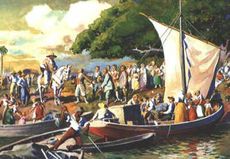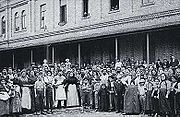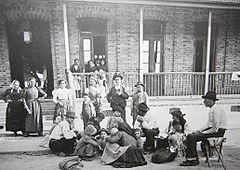
European immigration to Brazil
Encyclopedia
European immigration to Brazil refers to the movement of European people to Brazil. It should not be confused with the colonisation
of the country by the Portuguese.
During the first two of these periods, immigration to Brazil was almost exclusively of European origin, and it remained majoritarily so during all four of them, in spite of the increasing importance of Japanese immigration.
 Immigration properly started with the opening of the Brazilian ports, in 1808. The government began to stimulate the arrival of Europeans to occupy plots of land and become small farmers. After independence from Portugal, the Brazilian Empire focused on the occupation of the provinces of Southern Brazil. From 1824, immigrants from Central Europe
Immigration properly started with the opening of the Brazilian ports, in 1808. The government began to stimulate the arrival of Europeans to occupy plots of land and become small farmers. After independence from Portugal, the Brazilian Empire focused on the occupation of the provinces of Southern Brazil. From 1824, immigrants from Central Europe
started to populate what is nowadays the region of São Leopoldo
, in the province of Rio Grande do Sul
. Immigration stalled in 1830, due to legislation forbidding government spending with the settlement of immigrants. Besides, Rio Grande do Sul, the main target of immigration, was convulsed with civil war from 1835 to 1845.
Between 1820 and 1876, 350,117 immigrants entered Brazil. Of these, 45.73% were Portuguese, 35.74% of "other nationalities," 12.97% Germans
, while Italians
and Spanish
together did not reach 6%. The total number of immigrants per year averaged 6,000. Portuguese immigrants generally demanded the cities as established in commerce and peddling; others, particularly the Germans, were brought to settle in rural communities as small landowners. They received land, seed, livestock and other items to develop.

During this period, immigration was much more intense: large numbers of Europeans, especially Italians, were brought to the country to work in the harvest of coffee, their travel being paid by Brazilian government. From 1877 to 1903, almost two million immigrants arrived, at a rate of 71,000 per year
 By the beginning of the 1870s, the alternative of the interprovincial slave trade was exhausted, while the demand for workforce in the coffee plantations continued to expand. Thus the paulista oligarchy sought to attract new workers from abroad, by passing provincial legislation and pressing the Imperial government to organise immigration. Tensions arose between the governmental bureaucracy, that was concerned in populating the country with immigrants deemed easily adaptable to Brazilian culture and compatible with the racial prejudices of the time, and the coffee planters, eager for cheap labour force of whatever procedence; government concerns predominated while Italian and Spanish immigration was sufficient to meet the demand, but as early as 1892 pressure from the planters forced the government to abandon restrictions against Asian immigrants, although a serious crisis in the coffeculture by the end of the century postponed any practical initiatives concerning this until 1908.
By the beginning of the 1870s, the alternative of the interprovincial slave trade was exhausted, while the demand for workforce in the coffee plantations continued to expand. Thus the paulista oligarchy sought to attract new workers from abroad, by passing provincial legislation and pressing the Imperial government to organise immigration. Tensions arose between the governmental bureaucracy, that was concerned in populating the country with immigrants deemed easily adaptable to Brazilian culture and compatible with the racial prejudices of the time, and the coffee planters, eager for cheap labour force of whatever procedence; government concerns predominated while Italian and Spanish immigration was sufficient to meet the demand, but as early as 1892 pressure from the planters forced the government to abandon restrictions against Asian immigrants, although a serious crisis in the coffeculture by the end of the century postponed any practical initiatives concerning this until 1908.
with 22%. From 1914 to 1918, due to World War I
, the entry of immigrants of all nationalities decreased. After the War, the immigration of people of "other nationalities" redressed quicklier than that of Portuguese, Spaniards, and Italians. Part of this category was composed of immigrants from Poland
, Russia
and Romania
- whose emigration was prompted by the collapse of the Russian and Austrian-Hungarian Empires in the aftermath of the First World war - but part by non-Europeans, mainly Syria
n and Lebanese
people. Both subgroups included a number of Jewish immigrants, who arrived in the 1920s. Overall, European immigration remained clearly majoritary during the period, though Japanese immigration grew, and attempts to restrict immigration to Europeans, on racist bases, in 1921 and 1923, were defeated in the Brazilian Congress; however, attempts to organise Black American immigration to Brazil also failed due to administrative action by the Brazilian consulates in the United States, that systematically denied visa to Black applicants, on confidential orders by the Brazilian Foreign Affairs Ministry.
constituted 30% of total admissions.
With the radicalisation of the political situation in Europe, the end of the demographic crisis, the decadence of coffee culture, the Revolution of 1930 and the consequent rise of a nationalist government, immigration to Brazil was significantly reduced. The Portuguese remained the most significant group, with 39.35%.
Immigration also became a more urban phenomenon; most immigrants came for the cities, and even the descendents of the immigrants of the previous periods were moving intensely from the countryside. In the 1950s, Brazil started a program of immigration to provide workers for Brazilian industries. In São Paulo, for example, between 1957 and 1961, more than 30% of the Spanish
, over 50% of the Italian
and 70% of the Greek
immigrants were brought to work in factories.

 There seems to be no easy explanation of why slaves were not employed as wage workers at the abolition of slavery. One possibility is the influence of race-based ideas from the second half of the 19th century and early 20th century, which were based in the pseudo-scientific belief of the superiority of the "White race". On the other hand, Brazilian latifundiaries had been using slave manpower for centuries, with no complaints about the quality of this workforce, and there were not important changes in Brazilian economy or work processes that could justify such sudden preoccupation with the "race" of the labourers. Their embracing of those new, racist, ideas, moreover, proved quite flexible, even opportunist: with the slow down of Italian immigration since 1902 and the Prinetti Decree, Japanese immigration started in 1908, with any qualms about their non-Whiteness being quickly forgotten.
There seems to be no easy explanation of why slaves were not employed as wage workers at the abolition of slavery. One possibility is the influence of race-based ideas from the second half of the 19th century and early 20th century, which were based in the pseudo-scientific belief of the superiority of the "White race". On the other hand, Brazilian latifundiaries had been using slave manpower for centuries, with no complaints about the quality of this workforce, and there were not important changes in Brazilian economy or work processes that could justify such sudden preoccupation with the "race" of the labourers. Their embracing of those new, racist, ideas, moreover, proved quite flexible, even opportunist: with the slow down of Italian immigration since 1902 and the Prinetti Decree, Japanese immigration started in 1908, with any qualms about their non-Whiteness being quickly forgotten.
An important, and usually ignored, part of this equation was the political situation in Brazil, during the final crisis of slavery. According to Petrônio Domingues, by 1887 the slave struggles pointed to a real possibility of widespread insurrection. It was as a response to such situation that, on May 13, 1888, slavery was abolished, as a means to restore order and the control of the ruling class, in a situation in which the slave system was almost completely disorganised.
Another factor, also usually neglected, is the fact that, regardless of the racial notions of the Brazilian elite, European populations were emigrating in great numbers - to the United States, to Argentina, to Uruguay - which African populations certainly weren't doing, at that time. In this respect, what was new in "immigration to Brazil" was not the "immigration", but the "to Brazil" part. As Wilson do Nascimento Barbosa puts it,
Slavery was abolished by law (Lei Áurea
, signed by Regent Princess Isabel
) in 13 May 1888.
The influence of racist pseudo-scientific ideologies, then prevalent among the educated elites in the Western World, may have caused the Brazilian government to believe that the Brazilian national identity could only be built in the base of European immigration. However, other factors were possibly at work here, such as the necessity of bringing permanent immigrants (avoiding a phenomenon similar to the golondrina migration to Argentina was certainly a concern), implying the necessity of bringing immigrant families instead of lone individuals, and considerations about language, religion, and other cultural issues. Nevertheless, these government positions were never unopposed among the ruling landed class, which often pressed for a more lax policy on immigration, particularly when there was labour shortage.
The Lei Áurea set off a reaction among slave owners, which contributed to the erosion of the political foundations of the monarchy. After a few months of parliamentary crises, the Emperor was deposed by the military on November 15, 1889, and a Republican government established.
Colonial Brazil
In the history of Brazil, Colonial Brazil, officially the Viceroyalty of Brazil comprises the period from 1500, with the arrival of the Portuguese, until 1815, when Brazil was elevated to kingdom alongside Portugal as the United Kingdom of Portugal, Brazil and the Algarves.During the over 300 years...
of the country by the Portuguese.
History
Maria Stella Ferreira Levy suggests the following periodisation of the process of immigration to Brazil:- 1. 1820-1876: small number of immigrants (about 6,000 per year), predominance of Portuguese (45.73%), with significant numbers of Germans (12.97%);
- 2. 1877-1903: large number of immigrants (about 71,000 per year), predominance of Italians (58.49%);
- 3. 1904-1930: large number of immigrants (about 79,000 per year), predominance of the Portuguese (36.97%);
- 4. 1931-1963: declining number of immigrants (about 33,500 per year), predominance of the Portuguese (38.45%).
During the first two of these periods, immigration to Brazil was almost exclusively of European origin, and it remained majoritarily so during all four of them, in spite of the increasing importance of Japanese immigration.
First period: 1820-1876

Central Europe
Central Europe or alternatively Middle Europe is a region of the European continent lying between the variously defined areas of Eastern and Western Europe...
started to populate what is nowadays the region of São Leopoldo
São Leopoldo
São Leopoldo is an important Brazilian industrial city located in the south state of Rio Grande do Sul. It occupies a total area of 103.9 km² at circa 30 km from the State Capital, Porto Alegre. Climate is sub-tropical, with temperatures varying from 2°C minimum at Winter to more than...
, in the province of Rio Grande do Sul
Rio Grande do Sul
Rio Grande do Sul is the southernmost state in Brazil, and the state with the fifth highest Human Development Index in the country. In this state is located the southernmost city in the country, Chuí, on the border with Uruguay. In the region of Bento Gonçalves and Caxias do Sul, the largest wine...
. Immigration stalled in 1830, due to legislation forbidding government spending with the settlement of immigrants. Besides, Rio Grande do Sul, the main target of immigration, was convulsed with civil war from 1835 to 1845.
Between 1820 and 1876, 350,117 immigrants entered Brazil. Of these, 45.73% were Portuguese, 35.74% of "other nationalities," 12.97% Germans
German Brazilian
A German Brazilian is a Brazilian person of ethnic German ancestry or origin...
, while Italians
Italian Brazilian
-Italian immigration to Brazil:The Italian government claims there are 25 million Brazilians of Italian descent, which would be the largest population of Italian background outside of Italy itself. There are no actual surveys, or even verifiable calculations supporting such claims. According to...
and Spanish
Spanish immigration to Brazil
Spanish emigration peaked in the late 19th and early 20th centuries, and it was concentrated to Argentina and Cuba. Between 1882 and 1930, 3,297,312 Spaniards emigrated, of whom 1,594,622 went to Argentina and 1,118,960 went to Cuba...
together did not reach 6%. The total number of immigrants per year averaged 6,000. Portuguese immigrants generally demanded the cities as established in commerce and peddling; others, particularly the Germans, were brought to settle in rural communities as small landowners. They received land, seed, livestock and other items to develop.

Second Period: 1877-1903
In the last quarter of the 19th century, the entry of immigrants in Brazil grew strongly. On one hand, Europe underwent a serious demographic crisis, which resulted in increased immigration; on the other hand, the final crisis of Brazilian slavery prompted Brazilian authorities to find solutions for the problem of work force. Consequently, while immigration until 1876 was focused on establishing communities of landowners, during this period, while this older process continued, immigrants were more and more attracted to the coffee plantations of São Paulo, where they became employees or were allowed to cultivate small tracts of land in exchange for their work in the coffee crop.During this period, immigration was much more intense: large numbers of Europeans, especially Italians, were brought to the country to work in the harvest of coffee, their travel being paid by Brazilian government. From 1877 to 1903, almost two million immigrants arrived, at a rate of 71,000 per year

Third period: 1904-1930
From 1904 to 1930, 2,142,781 immigrants came to Brazil - making an annual average of 79,000 people. In consequence of the Prinetti Decree of 1902, that forbade subsidised emigration to Brazil, Italian immigration had, at this stage, a drastic reduction: their average annual entries from 1887 to 1903 was 58,000. In this period they were only 19,000 annually. As a consequence, immigration of non-Europeans was organised, with Japanese immigrants arriving from 1908 on. The Portuguese constituted 38% of entries, followed by SpaniardsSpanish immigration to Brazil
Spanish emigration peaked in the late 19th and early 20th centuries, and it was concentrated to Argentina and Cuba. Between 1882 and 1930, 3,297,312 Spaniards emigrated, of whom 1,594,622 went to Argentina and 1,118,960 went to Cuba...
with 22%. From 1914 to 1918, due to World War I
World War I
World War I , which was predominantly called the World War or the Great War from its occurrence until 1939, and the First World War or World War I thereafter, was a major war centred in Europe that began on 28 July 1914 and lasted until 11 November 1918...
, the entry of immigrants of all nationalities decreased. After the War, the immigration of people of "other nationalities" redressed quicklier than that of Portuguese, Spaniards, and Italians. Part of this category was composed of immigrants from Poland
Poland
Poland , officially the Republic of Poland , is a country in Central Europe bordered by Germany to the west; the Czech Republic and Slovakia to the south; Ukraine, Belarus and Lithuania to the east; and the Baltic Sea and Kaliningrad Oblast, a Russian exclave, to the north...
, Russia
Russia
Russia or , officially known as both Russia and the Russian Federation , is a country in northern Eurasia. It is a federal semi-presidential republic, comprising 83 federal subjects...
and Romania
Romania
Romania is a country located at the crossroads of Central and Southeastern Europe, on the Lower Danube, within and outside the Carpathian arch, bordering on the Black Sea...
- whose emigration was prompted by the collapse of the Russian and Austrian-Hungarian Empires in the aftermath of the First World war - but part by non-Europeans, mainly Syria
Syria
Syria , officially the Syrian Arab Republic , is a country in Western Asia, bordering Lebanon and the Mediterranean Sea to the West, Turkey to the north, Iraq to the east, Jordan to the south, and Israel to the southwest....
n and Lebanese
Lebanese people
The Lebanese people are a nation and ethnic group of Levantine people originating in what is today the country of Lebanon, including those who had inhabited Mount Lebanon prior to the creation of the modern Lebanese state....
people. Both subgroups included a number of Jewish immigrants, who arrived in the 1920s. Overall, European immigration remained clearly majoritary during the period, though Japanese immigration grew, and attempts to restrict immigration to Europeans, on racist bases, in 1921 and 1923, were defeated in the Brazilian Congress; however, attempts to organise Black American immigration to Brazil also failed due to administrative action by the Brazilian consulates in the United States, that systematically denied visa to Black applicants, on confidential orders by the Brazilian Foreign Affairs Ministry.
Fourth Period: 1931-1964
From 1931 to 1963, 1,106,404 immigrants entered Brazil, at an annual rate of 33,500. The participation of Europeans decreased, while that of Japanese increased. From 1932 to 1935 immigrants from JapanJapan
Japan is an island nation in East Asia. Located in the Pacific Ocean, it lies to the east of the Sea of Japan, China, North Korea, South Korea and Russia, stretching from the Sea of Okhotsk in the north to the East China Sea and Taiwan in the south...
constituted 30% of total admissions.
With the radicalisation of the political situation in Europe, the end of the demographic crisis, the decadence of coffee culture, the Revolution of 1930 and the consequent rise of a nationalist government, immigration to Brazil was significantly reduced. The Portuguese remained the most significant group, with 39.35%.
Immigration also became a more urban phenomenon; most immigrants came for the cities, and even the descendents of the immigrants of the previous periods were moving intensely from the countryside. In the 1950s, Brazil started a program of immigration to provide workers for Brazilian industries. In São Paulo, for example, between 1957 and 1961, more than 30% of the Spanish
Spanish immigration to Brazil
Spanish emigration peaked in the late 19th and early 20th centuries, and it was concentrated to Argentina and Cuba. Between 1882 and 1930, 3,297,312 Spaniards emigrated, of whom 1,594,622 went to Argentina and 1,118,960 went to Cuba...
, over 50% of the Italian
Italian Brazilian
-Italian immigration to Brazil:The Italian government claims there are 25 million Brazilians of Italian descent, which would be the largest population of Italian background outside of Italy itself. There are no actual surveys, or even verifiable calculations supporting such claims. According to...
and 70% of the Greek
Greek Brazilian
A Greek Brazilian is a Brazilian citizen of full, partial or predominantly Greek ancestry; or a Greek-born person residing in Brazil.The Greeks started immigrating in the end of the 19th and throughout the early and middle 20th century, in an attempt to find a better, more prosperous life, as well...
immigrants were brought to work in factories.
The role of European immigration in the transition from slave labour to wage labour


An important, and usually ignored, part of this equation was the political situation in Brazil, during the final crisis of slavery. According to Petrônio Domingues, by 1887 the slave struggles pointed to a real possibility of widespread insurrection. It was as a response to such situation that, on May 13, 1888, slavery was abolished, as a means to restore order and the control of the ruling class, in a situation in which the slave system was almost completely disorganised.
Another factor, also usually neglected, is the fact that, regardless of the racial notions of the Brazilian elite, European populations were emigrating in great numbers - to the United States, to Argentina, to Uruguay - which African populations certainly weren't doing, at that time. In this respect, what was new in "immigration to Brazil" was not the "immigration", but the "to Brazil" part. As Wilson do Nascimento Barbosa puts it,
-
- The collapse of slavery was the economic result of three conjugated movements: a) the end of the first industrial revolution (1760-1840) and the beginning of the so-called second industrial revolution (1880-1920); b) the lowering of the reproduction costs of the White man in Europe (1760-1860), due to the sanitary and pharmacological impact of the first industrial revolution; c) the raising costs of African Black slaves, due to the increasing reproduction costs of Black men in Africa.
Slavery was abolished by law (Lei Áurea
Lei Áurea
The Lei Áurea , adopted on May 13, 1888, was the law that abolished slavery in Brazil.It was preceded by the Rio Branco Law of September 28, 1871 , which freed all children born to slave parents, and by the Saraiva-Cotegipe Law , of September 28, 1885, that freed slaves when they reached the age of...
, signed by Regent Princess Isabel
Isabel, Princess Imperial of Brazil
Dona Isabel , nicknamed "the Redemptress", was the heiress presumptive to the throne of the Empire of Brazil, bearing the title of Princess Imperial....
) in 13 May 1888.
The influence of racist pseudo-scientific ideologies, then prevalent among the educated elites in the Western World, may have caused the Brazilian government to believe that the Brazilian national identity could only be built in the base of European immigration. However, other factors were possibly at work here, such as the necessity of bringing permanent immigrants (avoiding a phenomenon similar to the golondrina migration to Argentina was certainly a concern), implying the necessity of bringing immigrant families instead of lone individuals, and considerations about language, religion, and other cultural issues. Nevertheless, these government positions were never unopposed among the ruling landed class, which often pressed for a more lax policy on immigration, particularly when there was labour shortage.
The Lei Áurea set off a reaction among slave owners, which contributed to the erosion of the political foundations of the monarchy. After a few months of parliamentary crises, the Emperor was deposed by the military on November 15, 1889, and a Republican government established.

